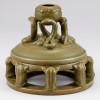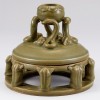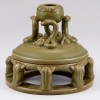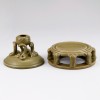본문
작품 정보
전체적으로 청색 유약이 시유된 뚜껑이 있는 벼루, 즉 벽옹 연(闢雍硯)입니다.
이 벼루는 그 형태가 주나라 황제가 귀족 자제들을 위해 설립한 중국의 고대 학교인 벽옹(闢雍)을 연상시키도록 만들어져 ‘벽옹 연(闢雍硯)’이라는 이름이 붙여졌습니다. 벽옹(闢雍)은 건물 사방이 물로 둘러싸인 독특한 건축물로, 청나라 강희제 이후 모든 황제들이 왕위에 오르면 이곳에서 강의를 하도록 되어 있었습니다.
뚜껑의 손잡이는 네 마리의 뱀이 둥근 완(碗)을 받치고 있는 형상을 하고 있습니다. 불가(佛家)에서는 이 네 마리의 뱀이 동서남북, 물과 불, 땅과 바람, 또는 사계절을 상징하는 존재로 여겨지며, 인간이 자연과 우주에 대해 느끼는 경외심을 나타냄과 동시에, 이러한 요소들이 가져다 주는 도전과 고난을 지혜롭게 극복해야 함을 강조합니다. 둥근 완(碗)은 붓을 씻는 그릇으로 연적과 붓을 씻는 그릇이 하나로 합쳐진 작품이라 할 수 있습니다.
전체적으로 벼루는 둥근 형태를 띠며, 윗면은 약간 오목하고 가장자리에 고리 모양의 홈이 있어 물이 새지 않도록 설계되었습니다. 단, 굽바닥에는 유약이 시유되지 않았습니다.
전체적인 기형과 조각, 제작된 시기로 보아 황제나 귀족이 사용했던 것으로 사료됩니다.
━━━━━
砚台有盖,通体施青色釉,为辟雍砚。
辟雍是周王朝为贵族子弟设立的大学,此砚因形制类似,故得名“辟雍砚”。辟雍是一座四周环水的独特建筑,自清朝康熙帝起,历代皇帝登基后都要在此讲学。
盖钮呈四条蛇环抱圆碗状。在佛教中,这四条蛇象征东西南北、水与火、土地与风,或四季,既表现了人类对自然与宇宙的敬畏之情,也强调了人应当智慧地克服来自这些元素的挑战与磨难。其上圆形碗是用于洗笔的器皿,可以说将砚滴与洗笔器的功能合二为一。
此砚整体呈圆形,砚面略微凹陷,边缘设有环形凹槽,以防止墨水溢出。砚底无釉。
从造型、雕刻工艺及制作时期来看,推测此器物曾供皇帝或贵族使用。
━━━━━
This is a Piyong inkstone (辟雍硯) with a lid, fully coated in a green glaze.
The name "Piyong Inkstone" derives from its resemblance to Piyong (辟雍), an ancient Chinese imperial academy established by the Zhou Dynasty emperors for the education of aristocratic descendants. Piyong was a distinctive architectural structure, surrounded by water on all sides, symbolizing wisdom and enlightenment. From the reign of the Kangxi Emperor in the Qing Dynasty onwards, every newly enthroned emperor was required to deliver lectures at Piyong as part of the imperial tradition.
The handle of the lid is designed in the form of four snakes supporting a circular bowl. In Buddhist tradition, these four snakes symbolize the four cardinal directions (east, west, south, north), the four elements (water, fire, earth, wind), or the four seasons. They represent humankind's reverence for nature and the universe, while also serving as a reminder of the challenges and hardships one must overcome with wisdom. The round bowl is a vessel used for washing brushes, combining the functions of both a water dropper and a brush washer into a single piece.
The inkstone itself has a circular form, with a slightly concave surface and a grooved ring along the edge to prevent water from spilling. The base, however, remains unglazed.
Judging by its overall shape, carvings, and the period in which it was made, it is believed to have been used by an emperor or nobility.
CONDITION
NOTICE
상담/문의 : 02- 730-5601 / 02- 730-7566 




